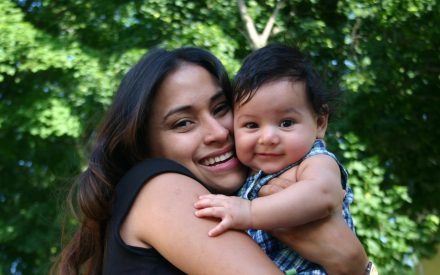Feeding your baby in a healthy way is important to help your child grow and develop. Good nutrition and healthy eating habits start from the beginning of life. Feeding is also a wonderful way to get to know your new baby!
Breastmilk or formula?
Breast milk alone is the best nutrition for your baby for about the first six months of life. All of the nutrition that he or she will need during this time is provided by breast milk.
- Breastfeeding: In the beginning, breastfed babies usually need to eat every two to three hours. Your baby is probably getting enough if you find frequent wet and dirty diapers, he or she looks satisfied after feeding, and your healthcare provider says that your baby is growing well.
- Formula feeding: Babies should not be given cow’s milk until 1 year of age. If you do not breastfeed, ask your healthcare provider about formula. Formula-fed babies usually eat every three to four hours. At one month old, most babies will eat 4 ounces of formula per feeding. This amount will increase to 6 to 8 ounces of formula by six months of age. The amount your baby eats may change from day to day and meal to meal as he or she goes through growth spurts.
How to feed your baby
- While feeding your baby, turn off the TV and give your baby all your attention.
- Hold your baby or sit with your baby, and talk to your baby.
- Feeding is a special time for the two of you to enjoy getting to know each other.
Heads up!
- Do not water down breast milk or formula as this will prevent your baby from getting all of the energy and nutrients needed.
- Always mix formula by following the direction on the package.
- Only put breast milk or formula in bottles.
- Never prop a bottle or leave your baby to feed alone. This can lead to tooth decay, ear infections, or choking.
Solid foods
- At six months old, breastmilk or formula is not enough to provide all of the iron, zinc, vitamin C, and other nutrients that your baby needs. Now is the time to introduce solid foods that will provide these nutrients and teach your baby about new flavors, textures, and skills needed for eating. Around six months start to look for these signs that your baby is ready for solid foods:
- she can sit up with some support and hold her head steady
- she will recognize food and open her mouth when a spoon approaches
- she no longer pushes food out of her mouth
- she can use her tongue to move food to the back of the mouth to swallow
- Common first foods are iron-fortified infant cereal or other foods high in iron, like pureed meats. If you use iron-fortified rice cereal, introduce it later and use it less frequently. After the first food, the order that foods are introduced is not important. Introduce one new single-ingredient food for 2 to 4 days before introducing another. With each new food watch for any reaction in your baby like diarrhea, rash, or vomiting. If you think your baby is having a reaction, stop feeding that food and call your doctor.
Feeding Your Baby
When you first start feeding your baby solid foods, make sure your baby is a little hungry but not overly hungry so he does not get frustrated when learning these new skills.
- Seat him in a high chair with a safety strap.
- Use a small baby spoon taking half spoonfuls of food.
- Place the spoon to your baby’s lips and let him take the lead.
- Watch for your baby to show signs that he is full.
Signs of hunger and fullness
The amount that your baby needs each day and meal will change, but she will know when she is hungry or full. Make sure to pay attention to these signs and not to push your baby to eat more once she has had enough.
Signs of Hunger
- Squirming and stretching
- Moving fists toward mouth
- Looking more alert
- “Rooting” or moving her head and jaw looking for your breast
- Watching the spoon
- Opening mouth for the spoon or reaching for it
Signs of Fullness
- Closing mouth tightly
- Stopping sucking, turning head, or letting go of nipple
- Becoming distracted or losing interest
- Pushing away spoon or bottle
- Falling asleep!
Safety first
- Wash your and your baby’s hands before meals.
- Clean all bottles, dishes, and high-chair tables with hot, soapy water and rinse well.
- Never microwave a bottle or baby food; bottles may be set in a bowl of warm water if desired.
- Check the temperature of any warmed bottles to make sure they are not too hot.
- Throw away any breast milk or formula left in the bottle after a feeding.
- Put baby food in a dish to feed from rather than feeding from the jar. Throw away any food left in the dish after the feeding.
Resources to explore
Help with breastfeeding is available from:
If you use formula, help is available from The American Academy of Pediatrics:

 Helping toddlers try vegetables
Helping toddlers try vegetables Feeding your baby from six to twelve months
Feeding your baby from six to twelve months Balancing food and physical activity
Balancing food and physical activity Nutrition for aging
Nutrition for aging


